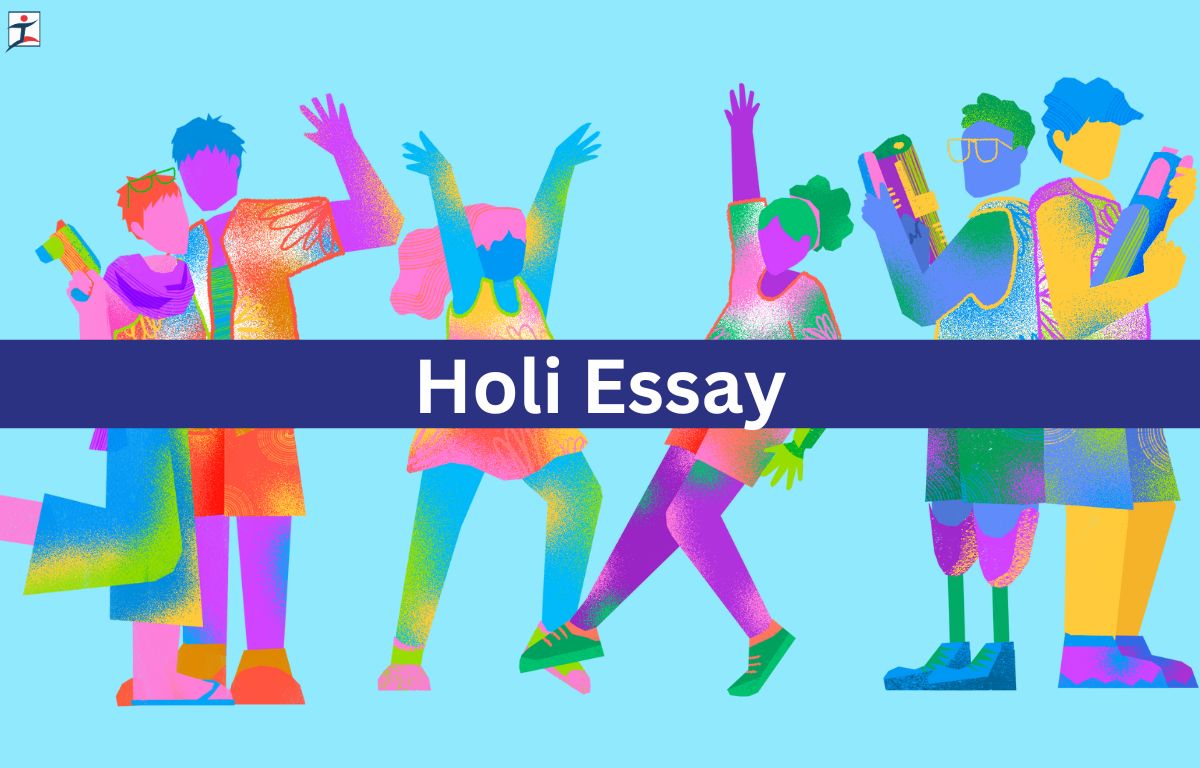Holi is a vibrant and joyous festival celebrated predominantly in India. People come together, forgetting differences, to revel in the spirit of unity and love. This year Holi will be celebrated on March 25, 2024. The festival marks the arrival of spring, and its hallmark is the playful throwing of colorful powders and water at friends and family. Streets are filled with laughter, music, and a riot of colors, as everyone joins in the lively festivities. Traditional sweets are shared, and festive meals bring communities together. It is a time to embrace diversity, let go of grudges, and welcome harmony and happiness, symbolizing the triumph of good over evil and the beginning of a new, colorful chapter in life.
All the students and children can check the Essay on Holi in an Easy and Simple way, 10 Lines, 150 words, 300 words, and 500 words provided in the article below. Read the complete article on Holi Essay.
10 Lines on Holi for Children
Below we have discussed 10 different lines on Holi:
- Holi is a vibrant Hindu festival celebrated in spring.
- People joyfully play with colored powders and water.
- It marks the triumph of good over evil.
- Friends and family come together to share happiness.
- Traditional sweets like Gujiya are enjoyed during Holi.
- Bonfires are lit the night before to symbolize victory.
- It is a time for forgiveness and starting anew.
- People wear white to better showcase the colorful fun.
- Holi transcends religious and cultural boundaries.
- Overall, it is a day of merriment and unity.
Essay on Holi in 150 Words
Holi, the festival of colors, is a vibrant celebration observed by Hindus worldwide. Occurring in spring, it symbolizes the triumph of good over evil and the arrival of joyous days. Celebrated by millions around the world, this Hindu festival fosters unity and happiness. As colorful powders fill the air, differences blur, and laughter resonates in every corner.
Holi’s roots lie in ancient legends, symbolizing the triumph of good over evil. Friends and family gather, drenched in hues, sharing sweets and laughter. It transcends boundaries, embracing all ages and backgrounds. The Festival sparks a sense of renewal, breaking free from the monotony of daily life.
Beyond its visual splendor, Holi teaches the importance of forgiveness and harmony. It encourages us to cherish relationships, rebuild bonds, and relish the diversity that colors our world. With its infectious energy and inclusivity, Holi stands as a testament to the beauty of shared moments and the enduring spirit of togetherness.
Essay on Holi in 300 Words
Holi, the vibrant festival of colors, is a joyous celebration marking the arrival of spring in India. This exuberant occasion is steeped in mythology, cultural significance, and the sheer joy of togetherness. The festival commences with a Holika Dahan, symbolizing the triumph of good over evil. As the bonfire crackles, people gather around, chanting prayers and immersing themselves in the sacred flames. This ritual reinforces the belief that light will always overcome darkness.
The next day is marked by the iconic throwing of colored powdered and water balloons, creating a kaleidoscope of hues. Friends and families come together, bridging gaps and fostering unity. The air resonates with laughter and merriment as people exchange warm wishes, sweets, and embrace the spirit of forgiveness.
Beyond its cultural roots, Holi transcends barriers, welcoming everyone to partake in its contagious enthusiasm. It emphasizes the beauty of diversity, as people of all ages, backgrounds, and religions join in the revelry. The colors of Holi signify the multitude of emotions that paint the canvas of life, reminding us to cherish every shade with acceptance and joy.
Holi’s significance extends beyond the physical act of coloring; it signifies the renewal of bonds, the triumph of love, and the spirit of rejuvenation. It encourages us to leave behind the mundane and embrace the vibrancy that life offers. In a world often divided, Holi stands as a testament to the power of celebration in fostering unity and joy.
In conclusion, Holi is more than a festival; it is a celebration of life, love, and the triumph of good over evil. With its vibrant colors and infectious joy, Holi brings people together, transcending boundaries and fostering a sense of community that resonates far beyond the festival itself.
Essay on Holi in 500 Words
Holi: The Festival of Colors
Holi, the vibrant festival celebrated by millions across India, marks the triumph of good over evil and the arrival of spring. This joyous occasion is a kaleidoscope of colors, laughter, and shared happiness, creating a lively atmosphere that transcends cultural boundaries.
Why is Holi Celebrated?
Holi’s roots lie in Hindu mythology, partially the legend of Holika and Prahlad. Prahald, a devotee of Lord Vishnu, withstood the evil intentions of his father’s sister, Holika. As a result, Holika was consumed by the fire she thought would harm Prahlad. This event symbolizes the victory of righteousness over malevolence. Thus, Holi serves as a reminder of the power of good and the eventual triumph of light over darkness.
When is Holi Celebrated?
Holi is celebrated on the last full moon day of the Hindu lunar month, usually falling in the month of March. This timing aligns with the change of seasons, marking the end of winter and the welcoming of spring. The entire nation comes alive with the colors of Holi, creating an exhilarating atmosphere that spreads happiness and warmth.
How is Holi Celebrated?
The festivities begin with a Holika Dahan, a ceremonial bonfire, on the eve of Holi. People gather around the fire to symbolically burn away their worries and sins, fostering a sense of renewal. The next day is the main event, where streets and open spaces transform into a riot of colors. Friends, family, and even strangers come together to play with powered colors, water balloons, and squirt guns, creating a mesmerizing spectacle of hues.
Amidst the color play, traditional sweets like gujiya and thandai are shared, strengthening bonds and fostering a sense of community. Holi is a great equalizer, erasing social barriers as people from all walks of life revel in the joyous chaos. Dance, music, and laughter fill the air as everyone partakes in the shared celebration.
In conclusion, Holi is not merely a festival; it is a celebration of life, love, and the triumph of good over evil. Its timing, amidst the changing seasons, mirrors the cyclical nature of life and the perpetual hope for renewal. The playfulness of color, the warmth of shared laughter, and the spirit of togetherness make Holi a truly unique and unforgettable experience. As the colors fade away, they leave behind a sense of unity, joy, and the promise of a brighter, more colorful future



 Top 5 IPMAT Coaching in Noida – Your G...
Top 5 IPMAT Coaching in Noida – Your G...
 Top 5 IPMAT Coaching in Delhi NCR (Updat...
Top 5 IPMAT Coaching in Delhi NCR (Updat...
 Top 5 IPMAT Coaching in Gurugram for Com...
Top 5 IPMAT Coaching in Gurugram for Com...







